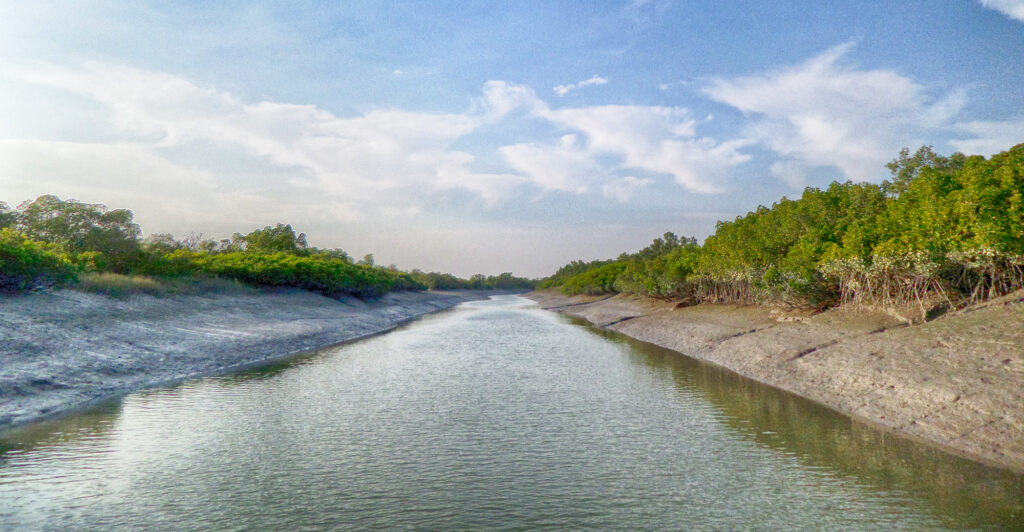I was standing on the banks of Passur river near the Sundarbans- the world’s largest continuous Mangrove forest, where hundreds of people live a life of uncertainty. At any time, they might lose their homes to the river, to a cyclone or the ever-expanding development projects slowly making their way near them. As I was talking to the people living on the embankments, I noticed the gaze of a middle-aged lady from afar. It was common for me to be approached by a community member who had time to spare on their hands. There was a group of people surrounding me thinking I was an NGO official here to support them. Maybe it was my glasses, height, or the clothes I was wearing, they never fail to miss me. Some asked for money, some for cows, some leaving the decision up to me. To rectify their thoughts, I introduced myself as a researcher here to learn more about their way of life. But they did not seem to understand and kept sharing their hardships. I summed up my conversation quickly and walked toward the lady who had my attention.
“Assalamualaikum. My name is Esha. How are you?” I asked. She looked at me with stiff eyes and said, “Good.” The absence of tenderness on her tanned face made me wonder what she has been through. Although I was daunted by her short answer, I quickly tried to advance our conversation. I thought to myself, “This is unusual. The people here are usually very friendly and always have many things to share. Am I a bad person in her story?” I scan her and notice a bundle of spinach and ask “Are you cooking spinach today? I enjoy it very much, especially with dried fish.” She softened and said, “I am cooking spinach with olive barb, would you like to come?” I did not want to miss this opportunity to get to know her and agreed to walk along to her home.
Vulnerability is not always visible
After a short conversation about what I do and why I am here, she began to confide in me.
“Seeing people from the countless NGOs and donors annoys me. They are always here for the people who live near the sea and over the embankment. If you see our house, you wouldn’t categorise us as poor, you will see land in front of our porch and think we are well off. The people near the sea are considered the most affected and get all the money, all the benefits. But the truth is, when a flood comes or a cyclone hits, we are affected more. The high water moves back to the river for them, but for us inside the embankment, there is no place for it to go. We are stranded inside, waterlogged for days, with no aid, food, or water. We cannot move from one place to another, but they can use boats to travel by the river. We are not categorised as impacted by shocks and stresses, but do you see any trees here? Before, that coconut tree was full of delicious coconuts but over the past few years we haven’t had a single one. The soil has become too saline for any kind of vegetation to grow. Fly ash from the industries are also killing all of our trees. But they do not see these problems, only the people over the embankments will get support because they do not have land for cultivation. What good is this land if nothing can grow on it?”
It was clear that she was not sharing her reality for me to help her. At that moment, she just needed someone to listen to her. I could sense her pain, and I could feel her frustration. “Remove the embankment, I will battle all the floods and cyclones Allah gives us, but at least we will get fertile sediment, at least the water will go away during periods of low tides.”
Complex issues require collaborative interventions
Indeed, in the last decade, there has been a growing movement to bring sediment onto the floodplains as it would reduce silt choking up rivers and in the long-term help increase freshwater retention. Understanding the differential impacts on coastal communities can help improve relief and disaster planning to protect the populations in need. These areas are well-known for severe cyclones and induced surges with at least one major tropical cyclone striking each year. With a growing population, thousands of people are forced to reside in low-lying areas that are highly susceptible to various natural calamities. With their nature-dependent livelihood sources such as agriculture, fishery, forestry, near-shore transportation and salt farming, any hazardous event impacts them more than one can see.
I thought to myself who should be held accountable for their struggles. One can blame the Global North for carbon emissions, one can blame the aid agencies for unsuitable technologies like the polder (embankment), one can blame the lack of investigation before support/aid distribution, one can blame the local politics or the haphazard industrialization. But one thing is for certain, climate change is not the sole contributor to their struggles, and these issues should be treated as multifaceted as they are.
Complexities of hazards, global emissions, fragmented social structures and institutions, should be acknowledged for what they are, and interventions should be designed accordingly- holistically. It is often not in the scope of donors and NGO-led interventions to address these complexities, but it is high time collaborative measures are taken. Decisions should be treated as products of complex interactions between individuals, their communities, their surroundings and the natural environment itself. Community members need to be actively involved in the process. Actions come with consequences, and consequences should not be unjust.
